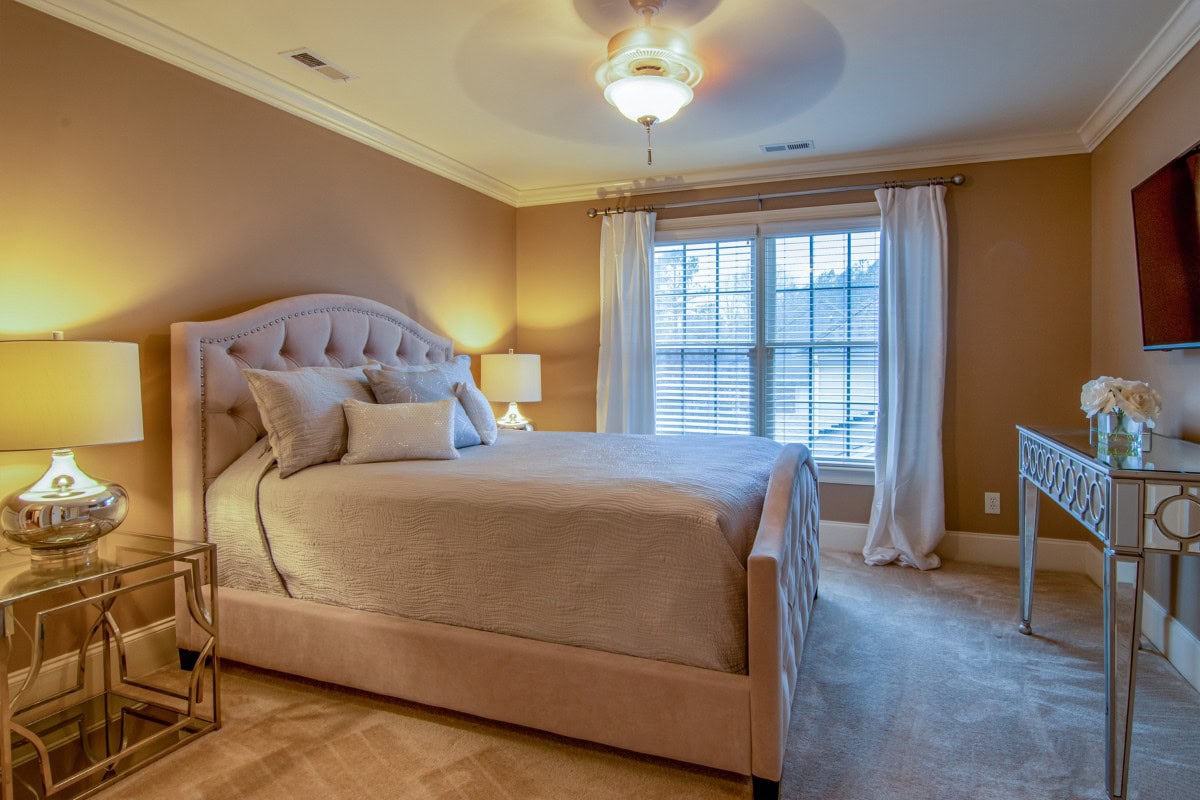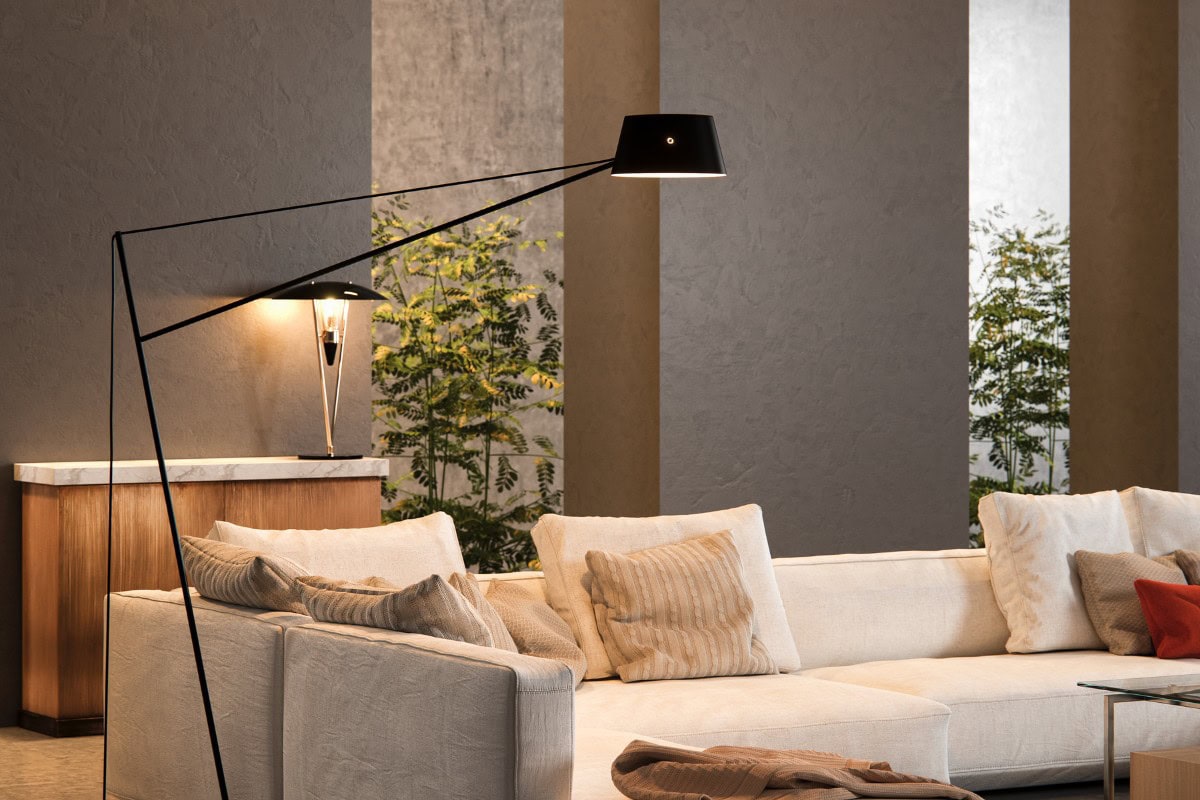It may seem silly to spend a lot of time planning the lighting layout of a room that is, by definition, supposed to remain dark for most of the time you’re in it. However, overlooking the importance of bedroom lighting can lead to both figurative and literal headaches.
Just like any other room in your home, your bedroom deserves some thoughtful consideration for lighting layout and design. You may think that your single overhead fixture is getting the job done just fine, but consider everything that goes on in a bedroom, and the lighting needs that come along with them. Searching for matching socks in the predawn darkness, applying makeup, dressing, reading, cleaning. The list goes on.
So, rather than coming at this project with the mindset that a bedroom is used only for sleeping, take a step back and realize that this room is just as multipurpose as any other room in your home. Therefore, bedroom lighting design deserves a little extra planning.
The purpose of this guide is to give you some good ideas for mapping out the perfect lighting for your unique bedroom. There will be few, if any, rigid rules here, but instead, universal guidelines that can be applied to different situations.
Here’s everything you need to know about proper bedroom lighting.
Why Bedroom Lighting Is Important
If you have ever stayed in a poorly lit bedroom, the problems become evident right away. Whether you are staying at a friend’s house or in a hotel, overly harsh, overly dark, or inconveniently placed lighting in a bedroom can make your life much more difficult than it needs to be.
The bedroom is where we all begin and end each day – two events which require significantly different light levels – yet so many people figure that a single nightstand lamp or a lighted ceiling fan is enough to handle all of the lighting needs of that room. Not true.
For starters, natural light matters in the bedroom, perhaps more so than in any other room. And what about those middle-of-the-night bathroom trips – do you want those lit by a harsh overhead light, or would a soft blue glow be easier on your half-asleep eyes?
The fact is, human beings are extremely sensitive to light levels and light cycles. We have evolved to be in a natural rhythm with daytime and nighttime, and having the wrong kind of lighting in your bedroom can make it difficult to fall asleep, difficult to wake up, or simply leave you feeling “off” throughout the day.
Circadian rhythm is an important consideration in bedroom lighting, and controlling the levels of both natural and artificial light available in the room can make a noticeable change in your overall physiological and mental health.
Consider Your Comfort Level
You spend a lot of time selecting the perfect mattress, the perfect comforter set, and the perfect sheets for your bedroom because in a bedroom, comfort matters. This rule also applies to lighting. A lack of personal comfort can throw you off more than you may realize, and when we are talking about a room designed from top to bottom to be comfortable, messing up the lighting seems like the equivalent of tripping at the finish line.
Here are a few things to be aware of when planning out your lighting.
Glare
Glare is overly bright or harsh lighting which can originate from natural or artificial light sources. In cases where glare is coming through a window, your best course of action will be to install blinds or curtains heavy enough to block out the harsh light when needed but which are also able to be pulled back during times when the glare is not present.
Glare can also come from things like uncovered or improperly shaded light bulbs, the wrong type of light fixture for the room, too many ambient lighting sources in the same room, or even simply the wrong types of light bulbs in your fixtures. In these cases, switching out entire fixtures and/or their components can help address glare problems.
Eyestrain
Eyestrain most often happens due to reading (or other work that requires lots of visual focus) done in low-light conditions. As your eyes struggle to focus, it puts unnecessary stress on the nerves and muscles of the eyes and, over time, can lead to larger problems with vision. Eyestrain can be relieved by installing task lighting where necessary.
Light Temperature
If you’ve ever changed a light bulb and realized that suddenly your room looks much colder and more harsh than it did with the previous light bulb, you have just experienced a change in light temperature. Light temperature moves in a spectrum from red to blue, with lower numbers falling in the red area and higher numbers in the blue.
We tend to light the inside of our homes in temperatures that fall somewhere in the yellow-to-white range – or somewhere between 2700K and 3500K. Generally speaking, the lighting in your bedroom will be most comfortable for you within this temperature range, although you are certainly encouraged to experiment to see which temperatures feel best for you. And remember that layered lighting offers you the chance to introduce several different light temperatures into your room which can be turned on or off as necessary.
Options for Nighttime
Something as simple as a nightlight can make a huge difference. When we wake in the middle of the night, our eyes need time to adjust to brighter light, which is why flicking on a harsh overhead light in a dark room feels so painful. There are many options available which can offer a gentle, dim lighting for nighttime. Whatever you choose, you want enough lighting to let you safely walk through a space without tripping but not enough to hurt your eyes.
Natural Light
Sometimes you want natural light in your bedroom, and sometimes you don’t. Natural light is terrific for helping us wake up in the morning, but it can also become problematic if, at a certain point in the day, the sun is streaming directly through one of your bedroom windows. The sun changes its position not only hour to hour but also month to month. A room that seems pleasantly lit in the summertime may experience direct glare from a low winter sun. Blinds and shades will give you control over how much natural light makes its way into your bedroom. This can be an especially important consideration for nurseries or children’s rooms, as they will nap during the day.
City Lights
For those living in the city, light can come pouring through your windows, even in the middle of the night. Lights from neighboring buildings, lighted advertisements, or even traffic can disrupt your natural sleep patterns. Blinds and shades are recommended in this situation as well.
Ambient Lighting in the Bedroom
Your source of ambient light in the bedroom can be a ceiling fixture, a floor lamp, a table lamp, or anything else that throws enough light to effectively cover the entirety of the room. Ambient light is considered the base light layer, so this should provide nice even lighting throughout the room.
Think along the lines of safety (not so dim that you trip over something) and visibility (not so dim that you can’t tell colors apart). Color rendering index, or “CRI” is another thing to consider, especially if your bedroom is where you get dressed or apply makeup. Broad daylight has a CRI of 100 – obviously much too bright for the inside of the bedroom, but you can still find light bulbs with a high CRI, which helps avoid that embarrassing moment where you realize you grabbed one brown shoe and one black shoe.
Task Lighting in the Bedroom
Task lighting is considered the second light layer in the room, built on top of ambient lighting. It is meant to be brighter than ambient lighting and can be used in concert with the main light source in a room or on its own. Task lighting will usually have a higher CRI than ambient lighting and is therefore put to very good use in bedrooms as vanity lighting.
Another great use for task lighting in the bedroom is reading lamps. These can be placed on nightstands, mounted to the wall above or next to the bed, or situated as a standing floor lamp with a swing arm next to a chair. Wherever you plan to do your reading in the bedroom, make sure you have adequate light to do it.
An often overlooked spot for task lighting is the closet interior. If you are relying on ambient lighting to penetrate into the back of your closet, there is a better solution. Installing a small light inside your closet can increase visibility tremendously and help with organization.
Accent Lighting in the Bedroom
Accent lighting can take many forms in a bedroom. For instance, a small LED light aimed at a picture or focal point can draw the eye of the observer. Or a recessed light could be aimed at an ornate piece of furniture to highlight its beauty.
The bedroom also offers many opportunities to play around with more creative accent lighting. For instance, some colorful LED strip lighting along the bottom of the bed frame can create a soft, colorful, or even color-changing glow. Individual bookshelves can be lit softly or brightly by strip lighting, rope lighting, or individual LEDs.
Smart technology has allowed us much more freedom when designing “light recipes” for different needs. You can pre-program soft romantic lighting, bright energizing lighting, restful light for reading before bed, and another lighting theme for dressing and makeup application, should you choose to go the more technical route.
Potential Light Setups
Here are your absolute minimum lighting requirements for a bedroom: one source of ambient lighting and one source of task lighting. Most often, this comes in the form of a ceiling fixture and a bedside lamp, although there are many other combinations possible. For instance, a floor lamp with a 3-way bulb and a wall sconce, a lighted ceiling fan and an adjustable gooseneck lamp, a large table lamp and track lighting, etc.
If you want to branch out beyond the basic light theme, consider adding in task lighting around a vanity, inside the closet, and in a sitting area, if applicable. If you want to branch out even further, look into accent lighting around focal points, along shelving or bookcases, and even along furniture.
Bedroom Lighting Mistakes to Avoid
Hopefully, this guide has got you excited at the prospect of changing up the lighting for your bedroom, but before you go running off to the hardware store, read over these common lighting mistakes to ensure you don’t make them yourself. You can avoid some costly changes later by getting it right the first time.
Here’s what to watch out for:
Casting Shadows
This problem most often shows up when a single, bright lighting source meets up with a large piece of furniture or a recessed area of the room. There are a few ways to avoid this issue. Firstly, design your lighting with your furniture in mind. Will that armoire create a shadowy corner? Is it impossible to see anything on that bookshelf?
The other thing to do is to consider more than one ambient light source, especially if your room has an alcove or more than one section. Remember, the goal of ambient light is to cover the entire room with a comfortable lighting level, so make sure nothing about your room is blocking that out.
Skipping Dimmer Switches
Dimmer switches may be most popular in living rooms and dining rooms but don’t overlook their usefulness in the bedroom. Being able to adjust the light level with the twist of a knob is pretty valuable, and in some cases, it might eliminate the need for additional lighting fixtures.
Clashing With the Paint Color
It’s not so much that the light itself will clash with the paint, but it’s more that certain types of lighting just make certain types of paint look terrible. Part of this goes back to the CRI, or color rendering index. There really can be a difference in the way colors appear under certain types of light. Hues may appear much lighter or darker than before, especially if you are playing around with the light temperature.
Another thing to keep in mind is the fact that dark colors tend to close a room in, while light colors and neutrals tend to open it up. If you have a small bedroom, no amount of lighting design will make the room appear bigger if it has dark gray or navy blue walls. If you are looking to create a feeling of spaciousness, consider changing out the paint color when you upgrade your lights.
Wrong Size Fixtures
Measure, measure, measure. When looking up at lights in a showroom, you are at a disadvantage because it is difficult to envision how it will look in your room. Either an oversized or an undersized lighting fixture can make the entire bedroom appear disproportionate. Make sure you have your room measurements with you anytime you shop for fixtures.
Consuming More Energy Than Necessary
For some, the transition from incandescent bulbs to CFL or LED is full of reluctance. That’s understandable. Change is not always easy, and until recently, LED technology was prohibitively expensive anyway. However, you should keep on top of current technology as much as you can, especially since it is so accessible and affordable now.
And affordability doesn’t simply extend to the fixtures themselves but also to your energy bill. Adding five new light fixtures, each with its own set of incandescent bulbs, will cost you significantly more in the long run. However, installing the same fixtures with LED bulbs will be cheaper to run, consume less energy, and require very infrequent bulb changes (we are talking in terms of decades here!)
So, take all of the information in this guide and apply it to your unique bedroom layout. Remember, there are no strict rules here, only helpful suggestions. The creativity falls to you.









